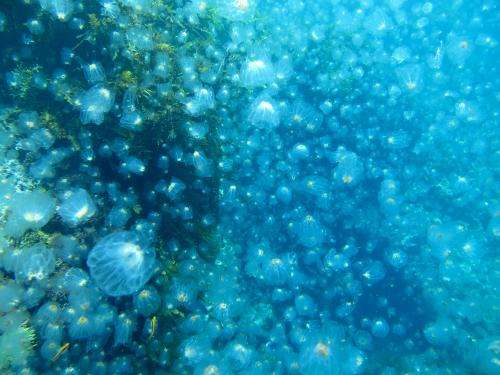Drifters-in-the-sea: salps bloom off the coast of New Zealand. Credit: Seacology
(Phys.org) —A small team of researchers working in Australia has found a link between trade winds that blow near the Great Barrier Reef and jellyfish blooms that impact swimmers along the coast. In their paper published in Journal of the Royal Society: Interface, the researchers describe how they studied weather patterns over a 27 year period and compared what they found with reported jellyfish stings and found a pattern that may help prevent jellyfish stings in the future.
There are a lot of jellyfish in the sea, some big, some small, some with relatively minor stings, others with stings that are not only painful but at times life threatening to humans. The Irukandji jellyfish (Carukia barnesi - a type of box jelly) is one of the latter, it's tiny—just about the size of the end of a human thumb—very nearly transparent when in water, and has a sting so severe that its symptoms have been given a name: Irukandji syndrome. The jellies also tend to live in groups, which means that one person can wind up with multiple stings, or multiple people can get stung in short order. On the plus side, the fact that they move in groups means that most of the time they pose little risk—it's only when they "bloom" and move close to shore that they become a problem.
Unfortunately, until now, it's been difficult if not impossible to predict when such a bloom might occur, offering beach managers a way of protecting swimmers. In this latest effort, the researchers believe they have found a way to give swimmers up to a day's warning. They compared weather data over the period 1985 to 2012 with reports of Irukandji syndrome and found a clear link between calm southeasterly trade winds near the Great Barrier Reef and stings on the shores nearby. They believe the calm winds impact currents, pulling they jellies near shore. They also believe that closing beaches after spotting calm easterlies would reduce the number of days that stings are reported by up to 61 percent.
Only time will tell of course, but if the easterly wind connection holds true to the past, beach managers, lifeguards and swimmers themselves may find the waters off the coast of Australia a lot safer in the future.
More information: Dangerous jellyfish blooms are predictable, Published 14 May 2014 DOI: 10.1098/rsif.2013.1168
Abstract
The potentially fatal Irukandji syndrome is relatively common in tropical waters throughout the world. It is caused by the sting of the Irukandji jellyfish, a family of box jellyfish that are almost impossible to detect in the water owing to their small size and transparency. Using collated medical records of stings and local weather conditions, we show that the presence of Irukandji blooms in coastal waters can be forecast on the basis of wind conditions. On the Great Barrier Reef, blooms largely coincide with relaxation of the prevailing southeasterly trade winds, with average conditions corresponding to near zero alongshore wind on the day prior to the sting. These conditions are consistent with hypotheses long held by local communities and provide a basis for designing management interventions that have the potential to eliminate the majority of stings.
Journal information: Journal of the Royal Society Interface
© 2014 Phys.org






















